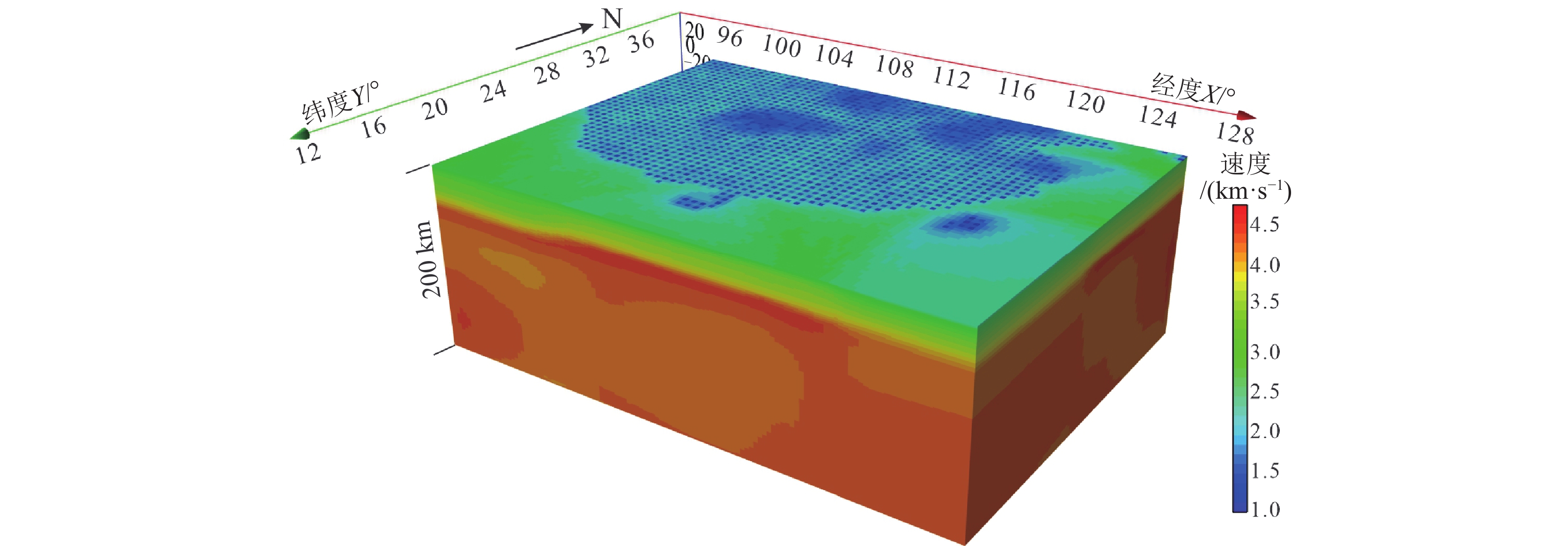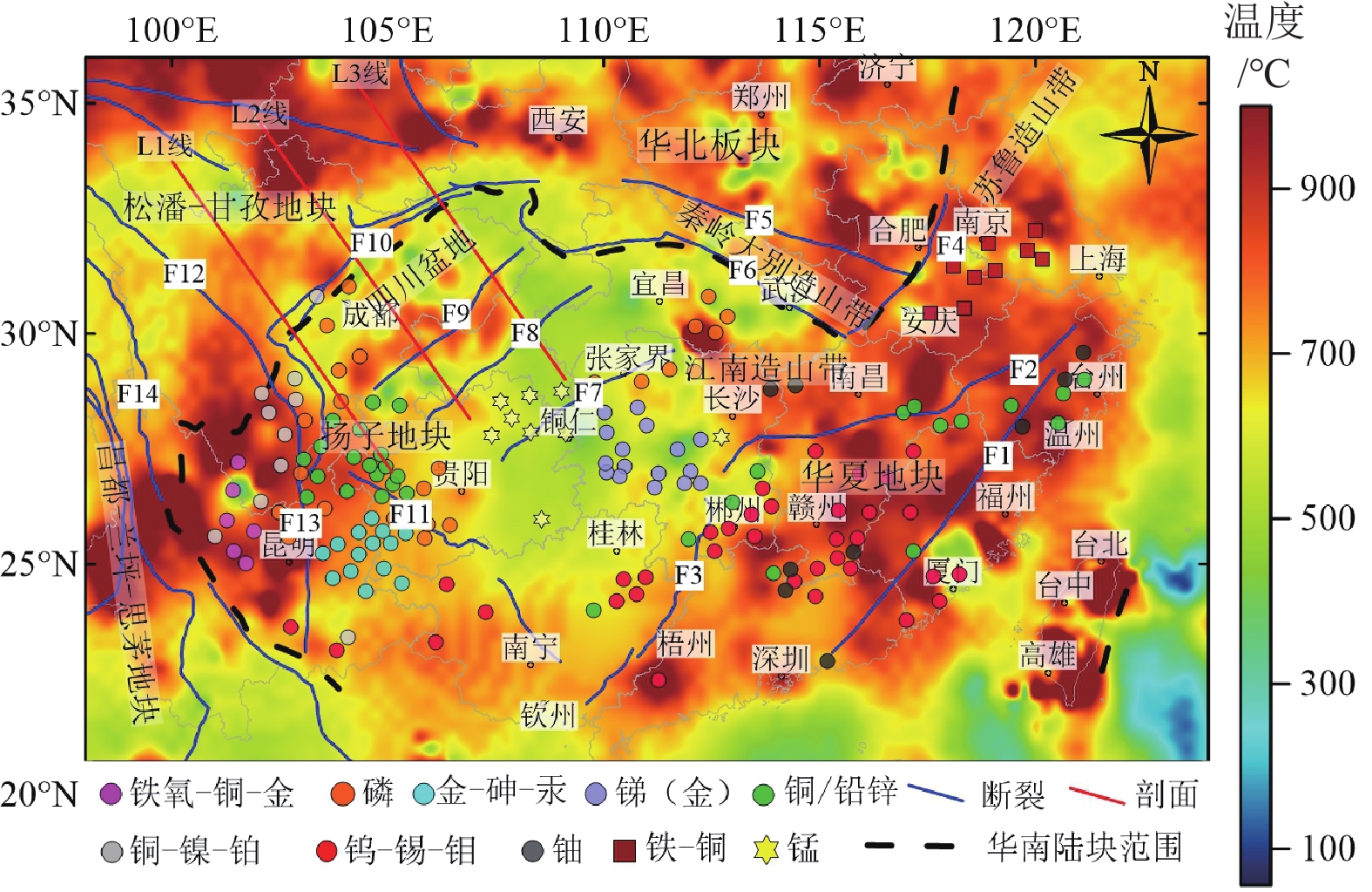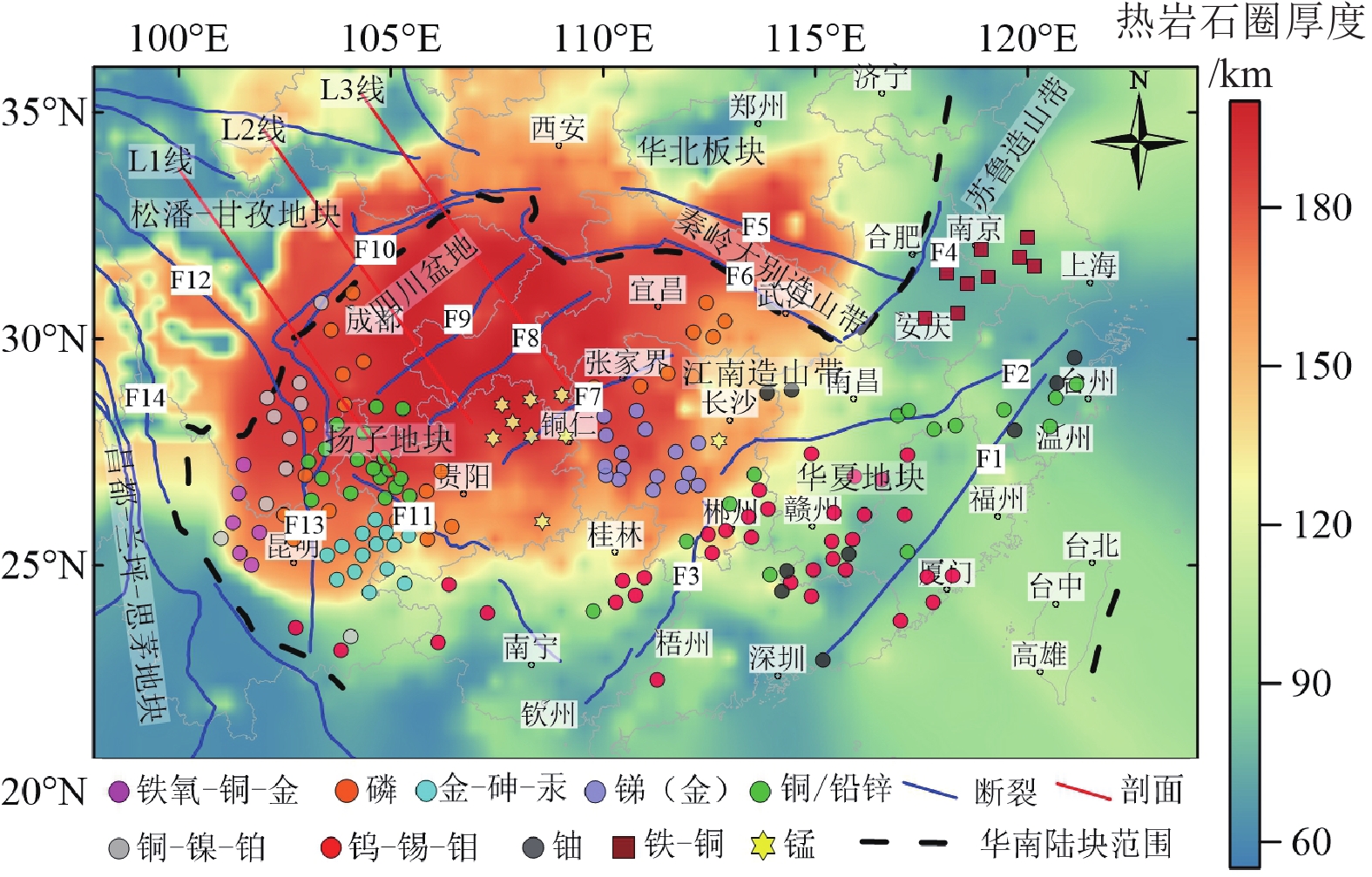The characteristic of lithospheric thermal structure and its tectonic implications in the South China block and adjacent areas
-
摘要:
华南陆块既是全球构造的重要组成部分,又是地质构造演化极复杂的区域。目前华南陆块与青藏高原东缘的耦合关系存在较大争议。岩石圈热结构中蕴含着丰富的构造变形、地质演化过程及地球动力学信息,可为深入认识华南陆块与青藏高原东缘的耦合关系提供有效约束。基于居里面深度和大地热流数据之间的函数关系,融合得到高空间分辨率的综合大地热流数据。并通过稳态热传导方程和综合大地热流数据,以及地震横波速度与温度之间关系,构建出华南陆块及邻区岩石圈热结构。通过分析岩石圈热结构中的壳幔热流分配、莫霍面温度与热岩石圈厚度结果,发现华夏地块、华北板块、江南造山带东北部和扬子地块东部属于“冷壳热幔”结构,而四川盆地和松潘−甘孜地块属于“热壳冷幔”结构;古太平洋板块向华南陆块的北西向俯冲和后撤作用可能是导致莫霍面温度与热岩石圈厚度变化趋势由北西向南东方向升高/增厚的原因。华南陆块与青藏高原东缘呈现相向运动,在地壳浅部,松潘−甘孜地块残留的刚性块体与扬子地块碰撞形成龙门山断裂带;而在地壳深部,扬子地块西缘受松潘−甘孜地块地壳熔融流体和深部热物质上涌引起的高温热侵蚀作用影响,逐步散失低温稳定性质。
Abstract:The South China Block (SCB) west of the eastern edge of the Qinghai−Tibetan Plateau (ETP) is both an important part of global tectonics and an area of extremely complex geological and tectonic evolution. The coupling relationship between the SCB and the ETP is currently highly controversial. The lithospheric thermal structure contains rich information on tectonic deformation, geological evolutionary processes and geodynamics, which can provide effective constraints for an in-depth understanding of the coupling relationship between the SCB and the ETP. The functional relationship between the depth of the Curie depth and the terrestrial heat flow data is used to obtain integrated terrestrial heat flow data and improve the spatial resolution of terrestrial heat flow data in the SCB. Then, the SCB’s reliable lithospheric thermal structure by the thermal steady-state conduction equation, integrated geodetic heat flow data, and the relationship between seismic S wave velocity and temperature. Analyses of crust-mantle heat flow distribution, Moho surface temperature and thermal lithospheric thickness in the lithospheric thermal structure show that the Cathaysia Block, the North China Plate, the northeastern part of the Jiangnan Orogenic Belt and the eastern part of the Yangtze Block belong to the ‘cold crust-hot mantle’ structure, whereas the Sichuan Basin and the Songpan-Ganzi Block belong to the ‘hot crust-cold mantle’ structure. The northwesterly subduction and retreat of the Palaeo-Pacific Plate to the SCB may be responsible for the northwesterly to southeasterly rise/thickening of both the temperature and thermal lithosphere thickness trends at the Moho surface. The SCB and the ETP show opposite movement. In the shallow part of the crust, rigid blocks of the upper crust of the SGB collide with the YB to form the Longmenshan Fault Zone. In the deep part of the crust, the Western YB is affected by thermal erosion (The SGB high-temperature indicated the partial melting fluids and the upwelling of deep thermal material), resulting in the progressive dissipation of low-temperature stable craton properties.
-
Key words:
- South China block /
- heat flow /
- lithospheric thermal structure /
- tectonic implications
-

-
图 2 华南陆块及邻区居里面深度(a)及实测大地热流(b)分布(断裂数据据舒良树,2012;张国伟等,2013;Shi et al., 2015)
Figure 2.
图 3 用于岩石圈深部(60 ~ 200 km)热结构计算的Vs波速度模型(Zhou et al., 2012)
Figure 3.
图 7 华南陆块及邻区地幔热流占总热流(Qm/Q)比例(矿床类型分布修改自Hu et al., 2017)
Figure 7.
表 1 不同层位岩石生热率和岩石热导率数据
Table 1. Rock heat generation rate and rock thermal conductivity data for different layers
层位 生热率 A/(μW·m3) 热导率 K/(W·m ℃) 参考文献 沉积层 1.294 2.5 Wang, 2001 上地壳 1.24 2.3 焦亚先等, 2014
臧绍先等, 2002中地壳 0.4 2.25 Artemieva et al., 2001 下地壳 0.1 2.0 上地幔 0.01 4.0 表 2 不同矿床与岩石圈热结构关键界面参数
Table 2. Key interface parameters between different deposits and lithospheric thermal structures
矿床 壳幔热流分配值 莫霍面温度/ ℃ 热岩石圈厚度/km 锰 0.37 ~ 0.45(0.40) 490.84 ~ 661.55(552.04) 152.45 ~ 198.42(189.07) 铅、锌 0.31 ~ 0.48(0.44) 609.80 ~ 863.72(768.73) 174.95 ~ 196.86(187.29) 金-砷-汞 0.44 ~ 0.48(0.46) 690.14 ~ 753.42(735.94) 114.68 ~ 169.07(162.62) 磷 0.36 ~ 0.51(0.47) 456.68 ~ 1160.49(675.25) 153.20 ~ 193.45(175.91) 锑(金) 0.45 ~ 0.66(0.54) 409.98 ~ 639.92(569.71) 160.47 ~ 186.56(172.59) 铁氧-铜-金 0.47 ~ 0.56(0.50) 786.28 ~ 988.92(893.66) 150.61 ~ 178.23(163.00) 铜-镍-铂 0.36 ~ 0.52(0.46) 654.65 ~ 908.34(820.67) 182.62 ~ 190.14(187.37) 钨-锡-钼 0.51 ~ 0.80(0.69) 509.33 ~ 938.35(733.93) 74.19 ~ 123.32(93.95) 铀 0.68 ~ 0.75(0.72) 763.39 ~ 990.41(859.64) 69.47 ~ 142.75(95.75) 铜 0.65 ~ 0.75(0.72) 532.51 ~ 1001.96(830.47) 78.49 ~ 127.65(90.80) 铁-铜 0.63 ~ 0.74(0.73) 738.68 ~ 888.94(782.40) 73.56 ~ 86.69(79.62) 注:括号中数字为中位数 -
[1] An M, Shi Y. 2006. Lithospheric thickness of the Chinese continent[J]. Physics of the Earth and Planetary Interiors, 159(3/4): 257−266.
[2] An M, Shi Y. 2007. Three−dimensional thermal structure of the Chinese continental crust and upper mantle[J]. Science in China Series D: Earth Sciences, 50(10): 1441−1451. doi: 10.1007/s11430-007-0071-3
[3] Artemieva I M, Mooney W D. 2001. Thermal thickness and evolution of Precambrian lithosphere: A global study[J]. Journal of Geophysical Research: Solid Earth, 106(B8): 16387−16414. doi: 10.1029/2000JB900439
[4] Artemieva I M. 2009. The continental lithosphere: Reconciling thermal, seismic, and petrologic data[J]. Lithos, 109(1): 23−46.
[5] Blakely R. 1995. Potential theory in gravity and magnetic application[M]. Cambridge University Press, Britain.
[6] Cermak V, Bodri L. 1986. Two−dimensional temperature modeling along east−European Geotraverses[J]. Journal of Geodynamics, 5(2): 133−163. doi: 10.1016/0264-3707(86)90003-7
[7] Cheng W B. 2009. Tomographic imaging of the convergent zone in Eastern Taiwan − A subducting forearc sliver revealed[J]. Tectonophysics, 466(3/4): 170−183.
[8] Christensen N I, Mooney W D. 1995. Seismic velocity structure and composition of the continental crust: A global view[J]. Journal of Geophysical Research: Solid Earth, 100(B6): 9761−9788. doi: 10.1029/95JB00259
[9] Clark M K, Royden L H. 2000. Topographic ooze: Building the eastern margin of Tibet by lower crustal flow[J]. Geology, 28(8): 703−706. doi: 10.1130/0091-7613(2000)28<703:TOBTEM>2.0.CO;2
[10] Cui Y, Zhu C Q, Qiu N S, et al. 2020. Geothermal lithospheric thickness in the central Jizhong depression and its geothermal significance[J]. Acta Geologica Sinica, 94(7): 1960−1969 (in Chinese with English abstract).
[11] Dong S W, Zhang Y Q, Long C X, et al. 2007. Jurassic tectonic revolution in China and new interpretation of the Yanshan movement[J]. Acta Geologica Sinica, 81(11): 1449−1461 (in Chinese with English abstract).
[12] Duffy T S, Anderson D L. 1989. Seismic velocities in mantle minerals and the mineralogy of the upper mantle[J]. Journal of Geophysical Research: Solid Earth, 94(B2): 1895−1912. doi: 10.1029/JB094iB02p01895
[13] Gao R, Wang H Y, Ma Y S, et al. 2006. Tectonic relationships between the Zoige basin of the Song−pan block and the west Qinling orogeny at lithosphere scale: Results of deep seismic reflection profiling[J]. Acta Geoscientica Sinica, 27(5): 411−418 (in Chinese with English abstract).
[14] Gibb T T, Cooper R F. 1998. Low−frequency shear wave attenuation in polycrystalline olivine: Grain boundary diffusion and the physical significance of the Andrade model for viscoelastic rheology[J]. Journal of Geophysical Research, 103: 27267−27279. doi: 10.1029/98JB02786
[15] Goes S, Govers R, Vacher P. 2000. Shallow mantle temperatures under Europe from P and S wave tomography[J]. Journal of Geophysical Research: Solid Earth, 105(B5): 11153−11169. doi: 10.1029/1999JB900300
[16] Griffin W L, O'Reilly S Y, Ryan C G. 1999. The composition and origin of sub−continental lithospheric mantle[C]//Fei Y, Bertka C M, Mysen B O. Mantle Petrology: Field Observations and High−pressure Experimentation (a Tribute to Francis R. (Joe) Boyd). Houston: The Geochemical Society: 13−45.
[17] Hacker B R, Gnos E, Ratschbacher L, et al. 2000. Hot and dry deep crustal xenoliths from Tibet[J]. Science, 287(5462): 2463−2466. doi: 10.1126/science.287.5462.2463
[18] Hou Z C, Li B G. 1985. Power spectrum methods for estimating the depths to the top and the bottom of magnetic source[J]. Computing Techniques for Geophysical and Geochemical Exploration, 7(4): 271−279 (in Chinese with English abstract).
[19] Hu R Z, Chen W T, Xu D R, et al. 2017. Reviews and new metallogenic models of mineral deposits in South China: An introduction[J]. Journal of Asian Earth Sciences, 137: 1−8. doi: 10.1016/j.jseaes.2017.02.035
[20] Hu S B, Wang J Y. 1994. Heat flow characteristics of orogenic belts in Southeastern China[J]. Geological Review, 40(5): 387−394 (in Chinese with English abstract).
[21] Huang X L, Xu Y G. 2010. Thermal state and structure of the lithosphere beneath eastern China: A synthesis on basalt −borne xenoliths[J]. Journal of Earth Science, 21(5): 711−730. doi: 10.1007/s12583-010-0111-3
[22] Jackson I. 2005. Laboratory measurement of seismic wave dispersion and attenuation at high pressure and temperature[C]//Advances in High−Pressure Technology for Geophysical Applications. Elsevier: 95−119.
[23] Jiang G, Hu S, Shi Y, et al. 2019. Terrestrial heat flow of continental China: Updated dataset and tectonic implications[J]. Tectonophysics, 753: 36−48. doi: 10.1016/j.tecto.2019.01.006
[24] Jiao Y X, Li W Z, Que Y Q, et al. 2014. Review on calculation method of geothermal lithospheric thickness[J]. Journal of Earth Science and Environment, 36(3): 123−129 (in Chinese with English abstract).
[25] Karato S. 1993. Importance of anelasticity in the interpretation of seismic tomography[J]. Geophysical Research Letters, 20(15): 1623−1626. doi: 10.1029/93GL01767
[26] Kennett B L N. 2005. Seismological tables: ak135[R]. Research School of Earth Sciences, Australian National University, Canberra, Australia: 1−289.
[27] Li C F, Lu Y, Wang J. 2017. A global reference model of Curie−point depths based on EMAG2[J]. Scientific Reports, 7(1): 1−9. doi: 10.1038/s41598-016-0028-x
[28] Li C F. 2011. An integrated geodynamic model of the Nankai subduction zone and neighboring regions from geophysical inversion and modeling[J]. Journal of Geodynamics, 51(1): 64−80. doi: 10.1016/j.jog.2010.08.003
[29] Luo F, Yan J Y, Fu G M, et al. 2020. Crust1.0 crustal model and its application: An example from Middle−Lower Yangtze metallogenic belt[J]. Acta Geologica Sinica, 94(2): 648−660 (in Chinese with English abstract).
[30] Luo F, Yan J Y, Zhang C, et al. 2022. The effective elastic thickness of lithosphere and its tectonic implications in the South China block[J]. Acta Geoscientica Sinica, 43(6): 771−784 (in Chinese with English abstract).
[31] Luo F. 2022. Research on satellite gravity and magnetic data processing methods and their application in South China tectonics[D]. East China University of Technology Dissertation for Doctoral Degree (in Chinese with English abstract).
[32] Mao J, Ye H, Liu K, et al. 2013. The Indosinian collision–extension event between the South China Block and the Palaeo−Pacific plate: Evidence from Indosinian alkaline granitic rocks in Dashuang, eastern Zhejiang, South China[J]. Lithos, 172: 81−97.
[33] Mckenzie D, Jackson J, Priestley K. 2005. Thermal structure of oceanic and continental lithosphere[J]. Earth and Planetary Science Letters, 233(3/4): 337−349.
[34] McKenzie D, Priestley K. 2008. The influence of lithospheric thickness variations on continental evolution[J]. Lithos, 102(1/2): 1−11.
[35] Nolet G, Zielhuis A. 1994. Low S velocities under the Tornquist‐Teisseyre zone: Evidence for water injection into the transition zone by subduction[J]. Journal of Geophysical Research: Solid Earth, 99(B8): 15813−15820. doi: 10.1029/94JB00083
[36] Ou Q, Lai J Q, Carvalho B B, et al. 2019. Different response to middle−Palaeozoic magmatism during intracontinental orogenic processes: Evidence from southeastern South China Block[J]. International Geology Review, 61(12): 1504−1521. doi: 10.1080/00206814.2018.1522518
[37] Parker R. 1973. The rapid calculation of potential anomalies[J]. Geophysical Journal International, 31(4): 447−455. doi: 10.1111/j.1365-246X.1973.tb06513.x
[38] Royden L H, Burchfiel B C, King R W, et al. 1997. Surface deformation and lower crustal flow in eastern Tibet[J]. Science, 276(5313): 788−790. doi: 10.1126/science.276.5313.788
[39] Rudnick R L, McDonough W F, O'Connell R J. 1998. Thermal structure, thickness and composition of continental lithosphere[J]. Chemical Geology, 145(3/4): 395−411.
[40] Shan B, Afonso J C, Yang Y, et al. 2014. The thermochemical structure of the lithosphere and upper mantle beneath south China: Results from multiobservable probabilistic inversion[J]. Journal of Geophysical Research: Solid Earth, 119(11): 8417−8441. doi: 10.1002/2014JB011412
[41] Shapiro N M, Ritzwoller M H. 2004. Thermodynamic constraints on seismic inversions[J]. Geophysical Journal International, 157(3): 1175−1188. doi: 10.1111/j.1365-246X.2004.02254.x
[42] Shi W, Dong S, Zhang Y, et al. 2015. The typical large−scale superposed folds in the central South China: Implications for Mesozoic intracontinental deformation of the South China Block[J]. Tectonophysics, 664: 50−66. doi: 10.1016/j.tecto.2015.08.039
[43] Shu L S. 2012. An analysis of principal features of tectonic evolution in South China Block[J]. Geological Bulletin of China, 31(7): 1035−1053 (in Chinese with English abstract).
[44] Sobolev S V, Zeyen H, Granet M, et al. 1997. Upper mantle temperatures and lithosphere−asthenosphere system beneath the French Massif Central constrained by seismic, gravity, petrologic and thermal observations[J]. Tectonophysics, 275(1/3): 143−164.
[45] Sobolev S V, Zeyen H, Stoll G, et al. 1996. Upper mantle temperatures from teleseismic tomography of French Massif Central including effects of composition, mineral reactions, anharmonicity, anelasticity and partial melt[J]. Earth and Planetary Science Letters, 139(1/2): 147−163. doi: 10.1016/0012-821X(95)00238-8
[46] Sun J, Jin G W, Bai D H, et al. 2003. Exploration of the electrical structure of the crust and upper mantle in the eastern margin of the Qinghai Tibet Plateau and its tectonic significance[J]. Science In China (Series D), 33(S1): 173−180,215 (in Chinese with English abstract).
[47] Sun Y, Dong S, Zhang H, et al. 2013. 3D thermal structure of the continental lithosphere beneath China and adjacent regions[J]. Journal of Asian Earth Sciences, 62: 697−704. doi: 10.1016/j.jseaes.2012.11.020
[48] Tanaka A, Okubo Y, Matsubayashi O. 1999. Curie point depth based on spectrum analysis of the magnetic anomaly data in East and Southeast Asia[J]. Tectonophysics, 306(3/4): 461−470.
[49] Teng J W. 2006. Research on layer−bundle fine structures and physical attributes of crust−mantle boundary in deep earth[J]. Journal of Jilin University (Earth Science Edition), 36(1): 1−23 (in Chinese with English abstract).
[50] Thurston J B, Smith R S. 1997. Automatic conversion of magnetic data to depth, dip, and susceptibility contrast using the SPI (TM) method[J]. Geophysics, 62(3): 807−813. doi: 10.1190/1.1444190
[51] Vacher P, Mocquet A, Sotin C. 1998. Computation of seismic profiles from mineral physics: the importance of the non−olivine components for explaining the 660 km depth discontinuity[J]. Physics of the Earth and Planetary Interiors, 106(3/4): 275−298. doi: 10.1016/S0031-9201(98)00076-4
[52] Wang J Y, Hu S B, Pang Z H, et al. 2012. Estimate of geothermal resources potential for hot dry rock in the continental area of China[J]. Science & Technology Review, 30(32): 25−31 (in Chinese with English abstract).
[53] Wang J Y, Wang J A. 1986. Mantle heat flow of Liaohe rifted basin in North China[J]. Acta Geophysica Sinica, 29(5): 450−458 (in Chinese with English abstract).
[54] Wang M Y, Di Q Y, Xu K, et al. 2004. Magnetization vector inversion equations and 2D forward and inversed model study[J]. Chinese Journal of Geophysics, 47(3): 528−534 (in Chinese with English abstract).
[55] Wang X B, Yu N, Gao S, et al. 2017. Research progress in research on electrical structure of crust and upper mantle beneath the eastern margin of the Tibetan plateau[J]. Chinese Journal of Geophysics, 60(6): 2350−2370 (in Chinese with English abstract).
[56] Wang X, Zhang G, Fang H, et al. 2014. Crust and upper mantle resistivity structure at middle section of Longmenshan, eastern Tibetan plateau[J]. Tectonophysics, 619/620: 143−148. doi: 10.1016/j.tecto.2013.09.011
[57] Wang Y. 2001. Heat flow pattern and lateral variations of lithosphere strength in China Mainland: Constraints on active deformation[J]. Physics of the Earth and Planetary Interiors, 126(3/4): 121−146.
[58] Wang Y, Zeng Q, Zhang S, et al. 2018. Spatial−temporal relationships of late Mesozoic granitoids in Zhejiang Province, Southeast China: Constraints on tectonic evolution[J]. International Geology Review, 60(11/14): 1529−1559. doi: 10.1080/00206814.2017.1369176
[59] Wang Z, Fukao Y, Zhao D, et al. 2009. Structural heterogeneities in the crust and upper mantle beneath Taiwan[J]. Tectonophysics, 476(3/4): 460−477.
[60] Wang Z, Wang J, Fu X G. 2021. Deep structure and crustal deformation in the Tethys tectonic domain of the easter Xizang (Tibetan) margin−Yangtze platform[J]. Geological Review, 67(1): 1−11 (in Chinese with English abstract).
[61] Wang Z, Zhao D, Wang J, et al. 2006. Tomographic evidence for the Eurasian lithosphere subducting beneath south Taiwan[J]. Geophysical Research Letters, 33(18): 510−527.
[62] Wang Z, Zhao D, Wang J. 2010. Deep structure and seismogenesis of the north−south seismic zone in southwest China[J]. Journal of Geophysical Research Solid Earth, 115: B12334.
[63] Wu Y M, Chang C H, Li Z, et al. 2007. Seismic tomography of Taiwan: Improved constraints from a dense network of strong motion stations[J]. Journal of Geophysical Research, 112: B08312.
[64] Xiong S Q, Yang H, Ding Y Y, et al. 2016. Characteristics of Chinese continent Curie point isotherm[J]. Chinese Journal of Geophysics, 59(10): 3604−3617 (in Chinese with English abstract).
[65] Yang P, Liu S W. 2022. Thermal structure of the continental lithospheric in Southeast China and its tectonic implications[J]. Geological Journal of China Universities, 28(5): 698−708 (in Chinese with English abstract).
[66] Yang X, Li Y, Afonso J C, et al. 2021. Thermochemical state of the upper mantle beneath South China from multi−observable probabilistic inversion[J]. Journal of Geophysical Research: Solid Earth, 126(5): e2020JB021114. doi: 10.1029/2020JB021114
[67] Zang S X, Liu Y G, Ning J Y. 2002. Thermal structure of the lithosphere in North China[J]. Chinese Journal of Geophysics, 45(1): 56−66 (in Chinese with English abstract).
[68] Zhang G W, Guo A L, Wang Y J, et al. 2013. Tectonics of South China continent and its implications[J]. Science China: Earth Sciences, 43(10): 1553−1582 (in Chinese with English abstract).
[69] Zhao G Z, Chen X B, Wang L F, et al. 2008. Electromagnetic detection evidence of the crustal "pipe flow" layer on the eastern edge of the Qinghai Tibet Plateau [J]. Science in China Press, 53(3): 345−350 (in Chinese with English abstract).
[70] Zhao P, Wang J Y, Wang J A, et al. 1995. Characteristics of heat production distribution in SE China[J]. Acta Petrologica Sinica, 11(3): 292−305 (in Chinese with English abstract).
[71] Zhou L, Xie J, Shen W, et al. 2012. The structure of the crust and uppermost mantle beneath South China from ambient noise and earthquake tomography[J]. Geophysical Journal International, 189(3): 1565−1583. doi: 10.1111/j.1365-246X.2012.05423.x
[72] 崔悦, 朱传庆, 邱楠生, 等. 2020. 冀中坳陷中部现今热岩石圈厚度及地热学意义探讨[J]. 地质学报, 94(7): 1960−1969. doi: 10.3969/j.issn.0001-5717.2020.07.005
[73] 董树文, 张岳桥, 龙长兴, 等. 2007. 中国侏罗纪构造变革与燕山运动新诠释[J]. 地质学报, 81(11): 1449−1461. doi: 10.3321/j.issn:0001-5717.2007.11.001
[74] 高锐, 王海燕, 马永生, 等. 2006. 松潘地块若尔盖盆地与西秦岭造山带岩石圈尺度的构造关系——深地震反射剖面探测成果[J]. 地球学报, 27(5): 411−418. doi: 10.3321/j.issn:1006-3021.2006.05.004
[75] 侯重初, 李保国. 1985. 计算磁性体上顶与下底深度的功率谱法[J]. 物探化探计算技术, 7(4): 271−279.
[76] 胡圣标, 汪集旸. 1994. 中国东南地区各造山带大地热流特征[J]. 地质论评, 40(5): 387−394. doi: 10.3321/j.issn:0371-5736.1994.05.001
[77] 焦亚先, 李文正, 阙永泉, 等. 2014. 地热学岩石圈厚度计算方法综述[J]. 地球科学与环境学报, 36(3): 123−129. doi: 10.3969/j.issn.1672-6561.2014.03.015
[78] 罗凡, 严加永, 付光明, 等. 2020. Crust1.0地壳模型及其应用: 以长江中下游成矿带为例[J]. 地质学报, 94(2): 648−660. doi: 10.3969/j.issn.0001-5717.2020.02.019
[79] 罗凡, 严加永, 张冲, 等. 2022. 华南陆块岩石圈有效弹性厚度及其构造意义[J]. 地球学报, 43(6): 771−784. doi: 10.3975/cagsb.2022.061901
[80] 罗凡. 2022. 卫星重磁数据处理方法及在华南构造研究中的应用[D]. 东华理工大学博士论文: 1−143.
[81] 舒良树. 2012. 华南构造演化的基本特征[J]. 地质通报, 31(7): 1035−1053. doi: 10.3969/j.issn.1671-2552.2012.07.003
[82] 孙洁, 晋光文, 白登海, 等. 2003. 青藏高原东缘地壳、上地幔电性结构探测及其构造意义[J]. 中国科学(D辑), 33(S1): 173−180,215. doi: 10.3321/j.issn:1006-9267.2003.z1.019
[83] 滕吉文. 2006. 地球深部壳−幔边界的层束精细结构与物理属性研究[J]. 吉林大学学报(地球科学版), 36(1): 1−23.
[84] 汪集旸, 胡圣标, 庞忠和, 等. 2012. 中国大陆干热岩地热资源潜力评估[J]. 科技导报, 30(32): 25−31. doi: 10.3981/j.issn.1000-7857.2012.32.002
[85] 汪集旸, 汪缉安. 1986. 辽河裂谷盆地地幔热流[J]. 地球物理学报, 29(5): 450−458. doi: 10.3321/j.issn:0001-5733.1986.05.004
[86] 王妙月, 底青云, 许琨, 等. 2004. 磁化强度矢量反演方程及二维模型正反演研究[J]. 地球物理学报, 47(3): 528−534. doi: 10.3321/j.issn:0001-5733.2004.03.025
[87] 王绪本, 余年, 高嵩, 等. 2017. 青藏高原东缘地壳上地幔电性结构研究进展[J]. 地球物理学报, 60(6): 2350−2370. doi: 10.6038/cjg20170626
[88] 王志, 王剑, 付修根. 2021. 青藏高原东缘−扬子特提斯构造域深部结构与地壳形变研究[J]. 地质论评, 67(1): 1−11.
[89] 熊盛青, 杨海, 丁燕云, 等. 2016. 中国陆域居里等温面深度特征[J]. 地球物理学报, 59(10): 3604−3617. doi: 10.6038/cjg20161008
[90] 杨鹏, 刘绍文. 2022. 中国东南地区岩石圈热结构特征及其构造意义[J]. 高校地质学报, 28(5): 698−708.
[91] 臧绍先, 刘永刚, 宁杰远. 2002. 华北地区岩石圈热结构的研究[J]. 地球物理学报, 45(1): 56−66. doi: 10.3321/j.issn:0001-5733.2002.01.008
[92] 张国伟, 郭安林, 王岳军, 等. 2013. 中国华南大陆构造与问题[J]. 中国科学: 地球科学, 43(10): 1553−1582.
[93] 赵国泽, 陈小斌, 王立凤, 等. 2008. 青藏高原东边缘地壳“管流”层的电磁探测证据[J]. 科学通报, 53(3): 345−350. doi: 10.3321/j.issn:0023-074X.2008.03.011
[94] 赵平, 汪集旸, 汪缉安, 等. 1995. 中国东南地区岩石生热率分布特征[J]. 岩石学报, 11(3): 292−305. doi: 10.3321/j.issn:1000-0569.1995.03.011
-




 下载:
下载:








